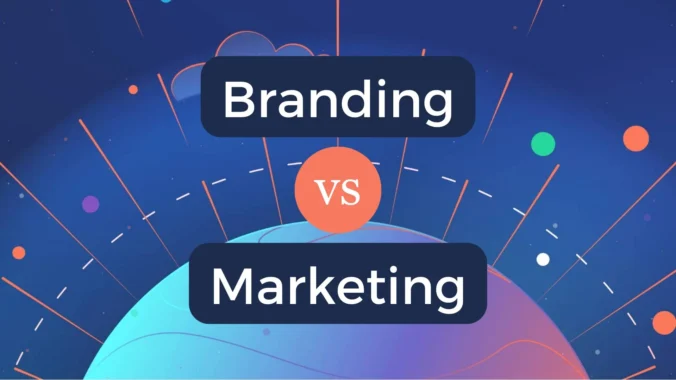While the terms “branding” and “marketing” are similar in meaning, they are very different in their purposes within the business world. Both no doubt have to be understood in detail for any organization that wants to establish its identity and ensure business growth.
This guide explains the core concepts of branding versus marketing to show how these two disciplines complement each other in defining long-term success.
What is Branding?
Branding can be defined as a way through which your business is identified. It includes everything which visually, emotionally, and culturally makes your brand unique and memorable.
Branding answers the question “Who are we?” and delivers mission, values, and personality to the target audience.
Key Components of Branding:
Branding is the essence of how your business communicates its identity and values to the world. From your logo and messaging to customer experience, each component works together to create a lasting impression and build trust with your audience.
Brand Identity
This would include things like a logo, color, and typography. Tools such as the selection of typeface help greatly in creating coherence and professionalism in identity creation.
Brand Voice
Defines how your brand speaks to its audience, whether formal, friendly, or playful.
Emotional Connection
Branding tries to instill confidence and loyalty through an emotional connection with customers by deploying tools such as brand storytelling.
Core Values and Purpose
Clearly articulating your brand’s mission and values lays the foundation for long-term recognition and customer loyalty.
Examples: Consider brands like Apple or Nike. Their logos, taglines, and messaging drive home innovation and empowerment, respectively, making them instantly recognizable.
What is Marketing?
Marketing refers to the strategies and tactics you will employ to promote your products or services and, therefore, generate sales. It answers the question, “How can we get people to buy from us?” Marketing is dynamic, often campaign-focused, and may utilize many different channels to reach potential customers.
Key Components of Marketing:
Marketing is the art of connecting with your audience to promote your products or services effectively. It combines strategies like market research, branding, advertising, and customer engagement to drive growth and build lasting relationships.
Market Research
Understand your target audience, competitors, and industry trends.
Marketing Channels
These include, but are not limited to, digital platforms like social media, email, and search; traditional ones will be print and TV advertisements.
Campaigns and Promotions
Short-term activities to increase awareness and sales; this could be seasonal discounts or the introduction of a new product.
Metrics and Analytics
Measure the effectiveness of campaigns with data-driven insights.
Examples: A restaurant running an ad digitally for the inclusion of a new menu item, or a realtor branding their services with targeted ads on Facebook.
Branding vs Marketing: Core Differences
While branding and marketing are interconnected, they serve different purposes and timelines. Here’s a deeper look at the differences of each:
| Aspect | Branding | Marketing |
| Purpose | Establishes identity and emotional connection | Promotes products/services to drive sales |
| Focus | Long-term | Short- to medium-term |
| Tools | Logos, brand voice, storytelling, typography | Ads, SEO, social media, email campaigns |
| Goal | Build trust and loyalty | Generate leads and conversions |
| Examples | Designing a compelling logo | Running a Google Ads campaign |
How Branding Supports Marketing Strategies
Branding is the foundation on which your marketing strategies will be built. An outstanding brand gives consistency and reliability to your marketing efforts.
1. Amplifying the Success of Campaigns
Well-defined branding makes it easier to create content since the direction of marketing campaigns would have been clearly articulated. For example, consistent typeface choices and messages set brands apart in saturated markets.
2. Raising Awareness of Your Brand
Branding creates a customer’s ability to recognize your business across the board-from a PR for brand awareness campaign down to digital ads. That is a guarantee of cohesive experience.
3. Building Emotional Involvement
Branding turns customers into loyal and, thus, more prone to give in to marketing activities. Pretty often, repeat business follows from emotional involvement created via brand storytelling.
Why Branding is Important in Marketing
Branding isn’t an art, but one effective strategy to further reinforce the efforts of marketing:
1. Differentiation: This makes you different in usually very competitive industries like restaurant marketing.
2. Trust Building: Consistent branding sends out a signal of professionalism and customers are more likely to trust your marketing messages.
3. Longevity: A good brand is permanent as an asset, whereas marketing campaigns disappear.
Branding versus Marketing in Business Scaling
Scaling a business requires both branding and marketing to play pivotal roles. Here is how each of them contributes:
Branding: It sets the bedrock, building a persona that attracts clients to your business.
Marketing: The engine that powers current sales and customer acquisition.
Taken together, these elements build off each other in a synergistic way. A branding agency in Canada could be creating a comprehensive identity while providing digital marketing services for the execution of targeted campaigns.
Branding Versus Advertising: Are They the Same?
Paid promotions are a subset of marketing, while branding is the process of creating an identity that lives on. While advertising creates attention, branding makes sure that attention translates into loyalty.
Key Difference: Advertising is about visibility; branding is about credibility.
Role of Branding in Digital Marketing
Digital marketing presents unparalleled opportunities to incorporate branding elements organically:
1. Social Media Presence
2. Consistent use of brand colors, fonts, and voice strengthens recognition.
3. Content Marketing
It means blogs, videos, and posts that showcase your brand’s personality create more engagement.
SEO and Keywords
Using keywords such as “PR marketing agency Canada” in content increases relevance and trust in the content.
Marketing vs Branding Examples
Branding Example: The red color of Coca-Cola or the “Share a Coke” campaign evokes emotions.
Marketing Example: Amazon’s email campaigns promoting Prime Day deals drive immediate purchases.
Building a Strong Branding and Marketing Relationship
For long-term success, branding and marketing must work hand in hand. Here’s how to ensure they align:
1. Consistency: Use branding elements like typeface selection across all marketing materials.
2. Strategy: Develop campaigns that reinforce your brand’s core values.
3. Collaboration: Partner with experts, such as a PR marketing agency Canada, to ensure seamless integration.
Conclusion: Balancing Branding and Marketing for Success
Branding and marketing are the two sides of one coin. While branding makes a ground for earning trust and recognition, on the other hand, marketing brings in immediate conversions. Both together promise to continue business growth more forcefully.
Be it realtor branding advice, restaurant marketing, or solely digital marketing services-one must balance all of them harmoniously.
At Tribe and Tales, we pride ourselves on developing well-rounded strategies that complement effective marketing techniques.
Let us help you decode the branding vs. marketing equation with unparalleled success.

A Marketing Communications and Advertising professional, I have worked across some of the biggest agency conglomerates like Publicis and WPP, handling the Communications mandate for brands like Shaadi.com, Reliance Fresh, Tanishq, Netflix and more.

Leave a Reply